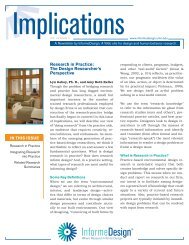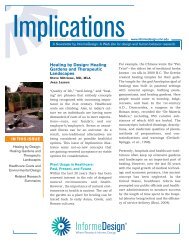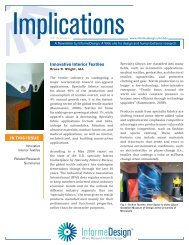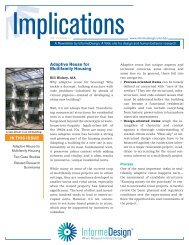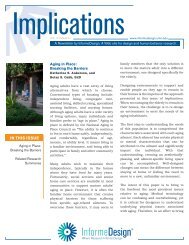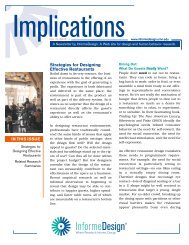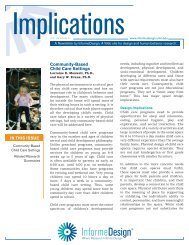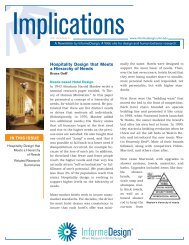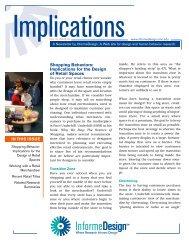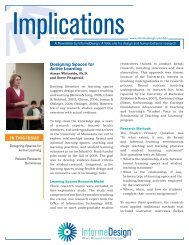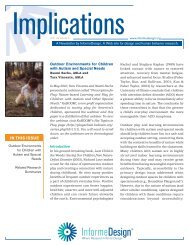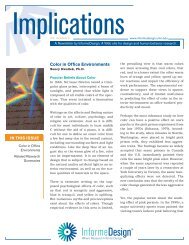Design, Landscape, and Health: Volume 5, Issue 4 - InformeDesign
Design, Landscape, and Health: Volume 5, Issue 4 - InformeDesign
Design, Landscape, and Health: Volume 5, Issue 4 - InformeDesign
Create successful ePaper yourself
Turn your PDF publications into a flip-book with our unique Google optimized e-Paper software.
Implications<br />
VOL. 05 ISSUE 04<br />
www.informedesign.umn.edu<br />
A Newsletter by Informe<strong>Design</strong>. A Web site for design <strong>and</strong> human behavior research.<br />
cover image<br />
goes here - fit<br />
image to the<br />
black box<br />
using the<br />
guidelines<br />
IN THIS ISSUE<br />
<strong>Design</strong>, <strong>L<strong>and</strong>scape</strong>,<br />
<strong>and</strong> <strong>Health</strong><br />
Healing <strong>and</strong><br />
Therapeutic Gardens<br />
Case Study: A<br />
Therapeutic Garden for<br />
People Living With HIV<br />
Related Research<br />
Summaries<br />
<strong>Design</strong>, <strong>L<strong>and</strong>scape</strong>, <strong>and</strong> <strong>Health</strong><br />
Steve Mitrione, MD, MLA<br />
The World is Our <strong>Health</strong>care System<br />
In the 21st century we have entered a<br />
new phase in the challenges confronting<br />
healthcare. The diseases that we face,<br />
<strong>and</strong> that continue to consume an increasing<br />
amount of our healthcare resources,<br />
are related to the environments of our<br />
own creation. There has been a dramatic<br />
increase in chronic conditions, such as<br />
obesity, diabetes, hypertension, <strong>and</strong> cardiovascular<br />
disease, partly related to an<br />
aging population, but increasingly related<br />
to the designed environment.<br />
These controllable yet currently incurable<br />
diseases are contributing to an increasing<br />
burden of disease within our society.<br />
Recent trends have also shifted this<br />
burden to the youngest members of our<br />
society, who, if current trends continue,<br />
may be the first generation to witness a<br />
decline in longevity. Disadvantaged <strong>and</strong><br />
minority populations also bear a disproportionate<br />
burden of these diseases, further<br />
compounded by their lack of access<br />
to quality healthcare. These populations<br />
are exposed to more pollution, have fewer<br />
healthy food choices, <strong>and</strong> live in communities<br />
with less access to recreation <strong>and</strong><br />
green space.<br />
According to Richard Jackson (2001), of<br />
the Center for Disease Control (CDC):<br />
The current design of our communities<br />
has created new health problems. Medicine<br />
will not be adequate to deal with the<br />
health challenges of the 21st century, not<br />
even with the help of the sequenced genome<br />
<strong>and</strong> advances in robotic surgery.<br />
Even though the United States spends one<br />
of every seven dollars on medical care, we<br />
will not significantly improve health <strong>and</strong><br />
the quality of life unless we pay more attention<br />
to how we design our living environments.<br />
<strong>Health</strong>y living environments include<br />
not just a clean <strong>and</strong> heated kitchen,<br />
bath or bedroom, but also the l<strong>and</strong>scape<br />
around us. <strong>Health</strong> for all, especially for the<br />
young, aging, poor <strong>and</strong> disabled, requires<br />
that we design healthfulness into our environments<br />
as well.<br />
In my experience as a primary care physician,<br />
I am continuously confronted<br />
with evidence that many of the diseases<br />
currently on the increase can be traced<br />
back to the ways in which we have designed<br />
our world. Diseases such as diabetes,<br />
hypertension, <strong>and</strong> cardiovascular<br />
disease, while multi-factorial in etiology,<br />
are all clearly linked to an increasingly<br />
sedentary population <strong>and</strong> with poor diet.<br />
Reliance on automobiles for transportation<br />
<strong>and</strong> sprawl of cities leads to poorer<br />
air quality <strong>and</strong> an increase in asthma,
Implications<br />
www.informedesign.umn.edu<br />
<br />
particularly among inner city youth. Lack of walkable<br />
<strong>and</strong> bikeable communities contributes to decreased<br />
levels of physical activity, which in turn increases the<br />
prevalence of obesity.<br />
Well-designed communities can foster social interaction,<br />
increasing social support <strong>and</strong> psychological<br />
wellbeing—two well-known determinants of health<br />
status <strong>and</strong> recovery from illness. Organizations such<br />
as the CDC, The Robert Woods Johnson Foundation,<br />
<strong>and</strong> the Environmental Protection Agency have<br />
all begun to examine <strong>and</strong> promote the development<br />
of community design that fosters health. Insurance<br />
companies have also begun to recognize the impact<br />
of design on community health.<br />
<strong>Design</strong> has an important impact upon the places<br />
where we provide healthcare. Hospitals, clinics, <strong>and</strong><br />
nursing homes are often designed for function, efficiency,<br />
<strong>and</strong> style. We know little about what the effect<br />
of these designed environments is upon people’s recovery<br />
from illness, though evidence has shown that<br />
design factors can reduce infection rates <strong>and</strong> errors<br />
in patient care <strong>and</strong> lead to shorter lengths of hospital<br />
stays. There is also much to be learned in the design<br />
of long term care facilities—potentially leading to better<br />
quality of life <strong>and</strong> lower hospitalization rates <strong>and</strong><br />
medication usage by residents. As our society ages<br />
<strong>and</strong> the utilization of long term care accelerates, improving<br />
the design of these facilities will be critical.<br />
Pollution <strong>and</strong> sedentary lifestyles resulting from urban sprawl<br />
contribute to a range of diseases.<br />
While conventional medicine <strong>and</strong> public health have<br />
much to contribute to our underst<strong>and</strong>ing <strong>and</strong> shortterm<br />
treatment of diseases <strong>and</strong> problems, they alone<br />
cannot control <strong>and</strong> reverse the systemic conditions<br />
that foster their development. <strong>Health</strong>care design is an<br />
emerging field that seeks to address some of these<br />
issues; it can be defined as the application of design<br />
in the provision of physical <strong>and</strong> mental services, preventative<br />
medicine, <strong>and</strong> treatments to individuals or<br />
the public.<br />
However, for design to play a broad <strong>and</strong> significant<br />
role in building <strong>and</strong> maintaining health, design <strong>and</strong><br />
research must be integrated despite differences in<br />
their premises, methods, <strong>and</strong> the language of their<br />
outcomes. This issue of Implications describes an integration<br />
of l<strong>and</strong>scape design <strong>and</strong> research for the<br />
purpose of optimizing user health.<br />
The next section discusses healing <strong>and</strong> therapeutic<br />
gardens, outlining current therapeutic garden design<br />
guidelines that are based on stress-response<br />
research, anecdotal evidence, <strong>and</strong> theories regarding<br />
stress reduction in well population groups. In the<br />
case study that follows, these guidelines are utilized<br />
as a basis for the initial design of a therapeutic garden<br />
for Clare Housing, an apartment building for patients<br />
with HIV disease. A methodology to test these<br />
guidelines is also proposed.<br />
Where Research Informs <strong>Design</strong>®
Implications<br />
www.informedesign.umn.edu<br />
<br />
Healing <strong>and</strong> Therapeutic Gardens<br />
Gardens have played a role in healthcare for centuries.<br />
With the advent of modern medicine in the beginning<br />
of the 20th century, the curative potential of<br />
gardens was lost. However, there has been renewed<br />
interest in utilizing garden environments as therapeutic<br />
entities to enhance the process of healing that<br />
occurs in healthcare environments.<br />
What Makes a Garden Therapeutic?<br />
‘Healing garden’ typically describes gardens designed<br />
to promote healing from illness. Healing, within the<br />
context of healthcare, is a broad term, seen as an<br />
improvement in overall well-being that incorporates<br />
the spiritual as well as the physical. A healing garden<br />
may provide relief from the psychological distress of<br />
disease <strong>and</strong> an improved sense of well-being, but it<br />
may or may not alter the disease outcome.<br />
A ‘therapeutic garden’ is more specifically designed to<br />
produce a given outcome upon a disease process. It<br />
can be thought of as similar to a medication that is<br />
taken for a specific disease or illness. The therapeutic<br />
garden is thus less focused on healing in a spiritual<br />
context (although it may also have this effect) <strong>and</strong><br />
more akin to the disease model of illness as practiced<br />
by most allopathic medical systems.<br />
Psychoneuroimmunology is an emerging field of medicine<br />
that examines the complex interplay between<br />
the immune system, central nervous system, <strong>and</strong> endocrine<br />
system. It is generally accepted that chronic<br />
stress leads to maladaptive changes that eventually<br />
impair our abilities to heal from illness. It is this<br />
component of illness that is most amenable to intervention<br />
by therapeutic gardens. By minimizing the<br />
stress response, therapeutic gardens can promote recovery<br />
from illness or preserve health. One can theorize<br />
that this effect is mediated by the sensory inputs<br />
associated with gardens. These inputs can involve<br />
all sense organs, but it is not currently known which<br />
is more important. For example, is viewing a garden<br />
more important than the sounds of a garden? What<br />
role do taste, touch <strong>and</strong> smell play, if any? In general,<br />
there has been little research into the characteristics<br />
of these gardens <strong>and</strong> their impact on the process of<br />
healing.<br />
At present, little data exists to guide the design of<br />
a therapeutic garden. Instead, general design guidelines<br />
have been developed <strong>and</strong> are generally accepted<br />
based on theories of stress reduction, encompassing<br />
six principles.<br />
1. Provide a sense of control by creating a variety<br />
of spaces. Spaces within a garden should be<br />
easily accessible by all user groups, provide for<br />
privacy, <strong>and</strong> include a variety of spaces that allow<br />
individuals to seek out spaces that best suit them.<br />
2. Provide for social support. Social support is<br />
associated with less stress than isolation, <strong>and</strong> has<br />
been linked with improved outcomes after heart<br />
attacks <strong>and</strong> cancer. Patient interviews highlight<br />
talking as a primary activity in garden settings.<br />
Gardens should provide spaces to accommodate<br />
various group sizes in a setting that encourages<br />
conversation.<br />
3. Provide for physical movement <strong>and</strong> exercise.<br />
Exercise is associated with reduced stress <strong>and</strong><br />
alleviation of depression in almost all population<br />
groups, but especially those with chronic illness.<br />
Where Research Informs <strong>Design</strong>®
Implications<br />
www.informedesign.umn.edu<br />
<br />
Gardens, because of their perceived pleasantness,<br />
can encourage exercise <strong>and</strong> movement. They<br />
should thus offer easy wayfinding <strong>and</strong> provide<br />
destinations that encourage mild exercise.<br />
4. Provide for access to nature <strong>and</strong> positive<br />
distractions. Exposure to nature <strong>and</strong> natural<br />
scenes is associated with decreased physiological<br />
stress responses. This response is dose-related in<br />
that the greater the percentage of greenery, as opposed<br />
to hardscape, the more likely the relaxation<br />
response is to occur. This relaxation response is<br />
believed to be ‘hardwired’ into our nervous systems<br />
by evolutionary responses to environments<br />
that favored survival.<br />
5. Minimize ambiguity. Stressed individuals<br />
respond negatively to ambiguity. Studies of inpatients<br />
recovering from surgery showed increased<br />
stress levels when exposed to abstract paintings<br />
as compared with natural scenes. This is believed<br />
to be due to the perception of ambiguous stimuli<br />
as negative in stressed individuals, congruent<br />
with their emotional state.<br />
6. Minimize intrusive stimuli. To exert their effect,<br />
therapeutic gardens need to minimize negative<br />
distractions such as noise, odor, <strong>and</strong> bright lights.<br />
Noise in particular can negate the positive effects<br />
associated with viewing nature.<br />
Case Study: A Therapeutic Garden<br />
for People Living With HIV<br />
Prescribing with the <strong>L<strong>and</strong>scape</strong><br />
Creating a therapeutic l<strong>and</strong>scape involves three<br />
steps:<br />
1. The evaluation of the disease <strong>and</strong>/or patient is<br />
used to generate potential target symptoms or disease<br />
processes to be addressed by the design.<br />
2. After attaining a thorough underst<strong>and</strong>ing of the<br />
disease, disease processes, <strong>and</strong> social <strong>and</strong> psychological<br />
factors, the design is created based upon<br />
the target symptoms that the designer wishes<br />
to ameliorate. In addition, the methodology for<br />
evaluating the influence of the garden on the patient<br />
population is developed. This methodology is<br />
based upon the intent of the design <strong>and</strong> is used to<br />
measure its effectiveness.<br />
3. Once the garden is installed <strong>and</strong> occupied, the<br />
health, psychological, <strong>and</strong> social parameters determined<br />
in the previous step are evaluated. The<br />
data collected are then used to determine the effectiveness<br />
of the design based upon the intended<br />
function of the garden. Undesired effects are also<br />
evaluated.<br />
The design of a therapeutic garden for Clare Housing,<br />
an apartment building for patients with HIV disease,<br />
illustrates the process by which therapeutic garden<br />
spaces may be designed <strong>and</strong> scientifically analyzed<br />
to determine their safety <strong>and</strong> effectiveness for a given<br />
user group.<br />
A water feature can mask undesired noises.<br />
1. Evaluating the Disease <strong>and</strong> the Patient<br />
HIV Disease<br />
Human immunodeficiency virus (HIV) attacks the<br />
immune system. Untreated, HIV disease is progressive<br />
<strong>and</strong> fatal. Death takes place over a period of<br />
months to years. Recent changes in the drug therapy<br />
of HIV disease has, however, created the opportunity<br />
to greatly extend the lives of people infected with<br />
HIV <strong>and</strong>, in some cases, lead to a remission of the<br />
disease. This life extension has paradoxically led to<br />
Where Research Informs <strong>Design</strong>®
Implications<br />
www.informedesign.umn.edu<br />
<br />
an increase in the number of individuals living with<br />
HIV disease, even as the rate of new infections has<br />
declined. For people living with HIV, it is known that<br />
stress can lead to increased viral replication <strong>and</strong> decreased<br />
effectiveness of drugs used to treat the disease.<br />
<strong>Design</strong> considerations based upon the health<br />
needs of people with HIV disease must therefore accommodate<br />
the following:<br />
• Minimize exposure to potential infections. Chosen<br />
plant material should be thornless <strong>and</strong> unlikely to<br />
harbor potential bacterial <strong>and</strong> fungal pathogens. In<br />
addition, st<strong>and</strong>ing water should not be present to<br />
prevent transmission of mosquito-borne illnesses.<br />
• The design should provide accessibility for people<br />
with decreased mobility.<br />
• Wayfinding should be clear as dementia may<br />
develop.<br />
• Shade should be provided as users may be sunsensitive<br />
due to medications used to treat HIV.<br />
housing administrative staff were also identified as<br />
secondary users. When surveyed, primary users<br />
indicated desires for a water feature, areas to<br />
cook outdoors, flower gardens, opportunities to<br />
garden, <strong>and</strong> spaces to socialize as well as meditate.<br />
Secondary users desired a space to hold staff<br />
meetings, events, <strong>and</strong> fundraisers, <strong>and</strong> to relax.<br />
The therapeutic garden design offered therapeutic<br />
spaces, each related to a specific theory <strong>and</strong> mechanism<br />
for stress reduction <strong>and</strong> amelioration of the disease<br />
process.<br />
The Garden Users<br />
To design a space that meets the needs of its intended<br />
users, an investigation into the primary <strong>and</strong><br />
secondary users of the space was performed. The<br />
primary users of the site were the apartment<br />
residents themselves. They were single adults, mostly<br />
HIV-positive, currently or previously homeless,<br />
<strong>and</strong> varied in terms of mental health, employment,<br />
<strong>and</strong> mobility. Social workers, case managers, <strong>and</strong><br />
The communal area.<br />
2. <strong>Design</strong>ing to Ameliorate Symptoms<br />
Social Support: The Communal Area<br />
The communal area functions to increase social support.<br />
Isolation is a major problem for those living<br />
with HIV disease, <strong>and</strong> can lead to depression, failure<br />
to comply with medical regimens, <strong>and</strong> poorer outcomes.<br />
This patio area provides an informal area for<br />
residents to gather <strong>and</strong> socialize. It is designed to be<br />
planted by the residents—who could choose plants to<br />
their liking—to promote communal involvement, to<br />
encourage gardening as a form of relaxation, <strong>and</strong> to<br />
provide residents with a creative outlet <strong>and</strong> a chance<br />
to interact during the planting. Wall seat plantings<br />
are accessible.<br />
Where Research Informs <strong>Design</strong>®
Implications<br />
www.informedesign.umn.edu<br />
<br />
Decreasing Stress: The Natural Area <strong>and</strong> the<br />
Meditative Area<br />
The viewing of nature is universally associated<br />
with decreased stress <strong>and</strong> a sense of psychological<br />
restoration. A natural area provides a place for<br />
small groups to view an area planted in a more<br />
natural form. The plantings are loosely arranged<br />
but clumped to create visual impact. Plants that attract<br />
wildlife were prioritized as they would increase<br />
the sense of wilderness that the site is intended to<br />
impart.<br />
The meditative area also functions to decrease arousal<br />
<strong>and</strong> stress. Meditative states are associated with<br />
positive physiological states of lowered blood pressure,<br />
pulse, <strong>and</strong> circulating stress hormones. A water<br />
feature was designed to enhance this state by providing<br />
a focus, positive distraction, <strong>and</strong> screening out intrusive<br />
visual <strong>and</strong> auditory stimuli. Conifer plantings<br />
were designed to provide a quiet <strong>and</strong> restful complement<br />
to the space. Their density would create a calm,<br />
enclosed space to facilitate a meditative experience.<br />
The garden walkway.<br />
Exercise: The Garden Walkway<br />
Exercise is associated with relaxation <strong>and</strong> induces a<br />
relaxation response. The site was designed to encourage<br />
walking within the site <strong>and</strong> positive distraction.<br />
The walkways are circular in layout to provide easy<br />
wayfinding for those residents who may suffer from<br />
dementia. The garden walkway plantings were selected<br />
to be bold <strong>and</strong> colorful, to stimulate the senses<br />
in a positive way, <strong>and</strong> to encourage movement to<br />
see what lies ahead. The plantings were designed for<br />
four season interest, shade <strong>and</strong> respite, <strong>and</strong> sheltered<br />
views to the street for “people watching.”<br />
3. Determining the Effectiveness of the <strong>Design</strong><br />
The therapeutic garden can be evaluated through<br />
several disease-specific, biological markers of disease<br />
activity (such as viral loads <strong>and</strong> CD4 counts), <strong>and</strong><br />
measures of mental health status, social functioning,<br />
<strong>and</strong> quality of life. Additionally, it may be useful to<br />
ascertain which areas of the garden are frequented<br />
most often by residents to determine if certain spatial<br />
qualities prove more successful than others in<br />
accomplishing the goals of the design. The hypothesis<br />
is that the installation of the garden will lead to<br />
an improvement in medical, psychiatric, <strong>and</strong> social<br />
indicators among the residents. Measurements of<br />
these health indicators should be made before <strong>and</strong><br />
after installation of the garden to determine what effect,<br />
if any, the garden has upon the health of the<br />
residents.<br />
Toward a New Paradigm of Therapeutic Gardens<br />
As the interest in the field of therapeutic gardens continues<br />
to exp<strong>and</strong>, system for research must be developed.<br />
The chairs of the American Society of <strong>L<strong>and</strong>scape</strong><br />
Architects (ASLA) Therapeutic Garden <strong>Design</strong><br />
Professional Interest Group have stated:<br />
We propose a renewed effort to encourage academic<br />
research that is useful to practitioners, <strong>and</strong> to provide<br />
publicity for the new research to get the word out. Research<br />
is important to validate intuition <strong>and</strong> to motivate<br />
policy change...We need research approaches that<br />
address current problems.<br />
These same sentiments are echoed throughout the<br />
literature <strong>and</strong> writings of l<strong>and</strong>scape architects interested<br />
in this field. And yet, there appears to be little<br />
progress in the answer to these calls.<br />
Where Research Informs <strong>Design</strong>®
Implications<br />
www.informedesign.umn.edu<br />
<br />
Perhaps what is missing is a paradigm that allows<br />
research to develop out of the design process. <strong>L<strong>and</strong>scape</strong><br />
architecture is first <strong>and</strong> foremost a design<br />
profession, <strong>and</strong> l<strong>and</strong>scape architects are primarily<br />
designers. The language of research <strong>and</strong> the language<br />
of design are different. What is needed is a process<br />
to translate design into research <strong>and</strong> research into<br />
design. The two must become linked for any<br />
progress to be made. An effective process will be<br />
cyclical <strong>and</strong> seamless, with research, design, <strong>and</strong><br />
analysis forming a continuous loop that ultimately<br />
leads to the development of design guidelines. These<br />
guidelines themselves are constantly in flux as new<br />
information is collected, new designs are created, <strong>and</strong><br />
analysis leads to new insights.<br />
Conclusion<br />
<strong>Design</strong> has always been<br />
important to health. How<br />
we shape our homes,<br />
neighborhoods, towns,<br />
cities, <strong>and</strong> regions ultimately<br />
impacts our ability<br />
to stay healthy. When<br />
we become ill, the design<br />
of our clinics, hospitals,<br />
<strong>and</strong> nursing homes impacts<br />
our ability to get<br />
well. <strong>Design</strong> issues related to health <strong>and</strong> healthcare<br />
are, however, complex. There is a distinct need for<br />
collaboration between design professionals <strong>and</strong> members<br />
of the scientific <strong>and</strong> healthcare professions, such<br />
as, public health professionals, epidemiologists, physicians,<br />
<strong>and</strong> nurses, to name a few. It is my belief<br />
that the solutions to reverse the deterioration in our<br />
nation’s health <strong>and</strong> spiraling healthcare costs lie at<br />
the intersection of disciplines. It is only when all of<br />
those involved in creating <strong>and</strong> underst<strong>and</strong>ing healthy<br />
<strong>and</strong> healing environments are working collaboratively,<br />
can meaningful solutions be found. <strong>Design</strong>ers are,<br />
perhaps unknowingly, already involved in creating<br />
“experiments” through design. Every building, l<strong>and</strong>scape,<br />
city, <strong>and</strong> regional design is a hypothesis about<br />
what is best for a given problem. Human subjects<br />
then interact with the design with a resulting impact<br />
upon them. What is missing in the design professions<br />
is a means to evaluate the results <strong>and</strong> use this data<br />
to inform future design. Research needs to inform<br />
design <strong>and</strong> design needs to inform research.<br />
About the Author:<br />
Steve Mitrione, MD, MLA, is a<br />
family physician with 20 years of<br />
clinical experience. Dr. Mitrione<br />
recently received his MLA from<br />
the University of Minnesota <strong>and</strong><br />
is one of only two individuals in<br />
the United States to hold both degrees.<br />
His focus is on the ways in<br />
which l<strong>and</strong>scape <strong>and</strong> the designed environment can<br />
improve health <strong>and</strong> aid in the recovery from illness.<br />
References<br />
—Cole, S., Naliboff, B., Kemeny, M., Griswold, M.,<br />
Fahey, J., & Zack, J. (2001). Impaired response<br />
to HAART in HIV-infected individuals with high<br />
autonomic nervous system activity. Proceedings of<br />
the National Academy of Sciences, USA, 98, 12695-<br />
12700.<br />
—Epstein, M., & Sachs, N. (2005, Summer). Therapeutic<br />
Garden <strong>Design</strong> newsletter, 4.<br />
—Mace, L., Bell, P., & Loomis, R. (1999). Aesthetic,<br />
affective <strong>and</strong> cognitive effects of noise on natural<br />
l<strong>and</strong>scape assessment. Society <strong>and</strong> Natural Resources,<br />
12, 225-242.<br />
—Paine, R., Francis, C., Marcus, C. & Barnes, M.<br />
(1998). Hospital outdoor spaces. In Marcus, C. &<br />
Francis, C. (Eds.), People places: <strong>Design</strong> guidelines.<br />
(pp. 311-343). New York: Wiley.<br />
Where Research Informs <strong>Design</strong>®
Implications<br />
www.informedesign.umn.edu<br />
<br />
—Ruuskanen, J., & Parketti, T. (1994). Physical<br />
activity <strong>and</strong> related factors among nursing home<br />
residents. Journal of the American Geriatrics Society,<br />
42, 987-991.<br />
—Speigel, D., Kraemer, H., Bloom, J., & Gottheil,<br />
E. (1989). Effects of psychosocial treatment on<br />
survival of patients with metastatic breast cancer.<br />
The Lancet 2, 888-891.<br />
—Ulrich, R. (1999). Effects of gardens on health<br />
outcomes: Theory <strong>and</strong> research. In Marcus, C. &<br />
Barnes, M. (Eds.), Healing gardens: Therapeutic<br />
benefits <strong>and</strong> design recommendations (pp. 27-86).<br />
New York: Wiley.<br />
—Ulrich, R., Lunde, O., & Eltinge, J. (1993). Effects<br />
of exposure to nature <strong>and</strong> abstract pictures on<br />
patients recovering from heart surgery. Psychophysiology,<br />
30, suppl. 1, 7.<br />
“<strong>Health</strong> Benefits of Including Nature Within<br />
Hospitals”—Journal of Environmental Psychology<br />
“Pediatric Healing Gardens”<br />
—<strong>L<strong>and</strong>scape</strong> <strong>and</strong> Urban Planning<br />
“Alleviating Mental Fatigue in Urban <strong>and</strong> Natural<br />
Settings”—Journal of Environmental Psychology<br />
“Creating Facilities for AIDS Patients”<br />
—Journal of Architectural <strong>and</strong> Planning Research<br />
“Window Views Affect Well-Being <strong>and</strong> Residential<br />
Satisfaction”—Environment <strong>and</strong> Behavior<br />
“Tranquil <strong>and</strong> Pleasing Natural Environments”<br />
—Journal of Environmental Psychology<br />
“A Review of <strong>Health</strong> Effects <strong>and</strong> Urban <strong>Design</strong>”<br />
—<strong>L<strong>and</strong>scape</strong> <strong>and</strong> Urban Planning<br />
—Ulrich S., Simons, R., Losito, B., Fiorito, E., Miles,<br />
M., & Zelson, M. (1991). Stress recovery during<br />
exposure to natural <strong>and</strong> urban environments.<br />
Journal of Environmental Psychology, 11, 201-230.<br />
Related Research Summaries<br />
The Informe<strong>Design</strong> Web site has many Research<br />
Summaries on design, l<strong>and</strong>scapes, <strong>and</strong> health. This<br />
knowledge will be valuable to you as you consider<br />
your next design solution <strong>and</strong> is worth sharing with<br />
your clients <strong>and</strong> collaborators.<br />
“<strong>Design</strong>ing for the <strong>Health</strong> Process”<br />
—World Hospitals <strong>and</strong> <strong>Health</strong> Services<br />
“End of Life Care”—The Journal of Alternative <strong>and</strong><br />
Complementary Medicine<br />
Photos Courtesy of:<br />
The Metropolitan <strong>Design</strong> Center, Regents of the<br />
University of Minnesota (pp. 1-4).<br />
Steve Mitrione (remainder).<br />
The Mission<br />
The Mission of Informe<strong>Design</strong> is to facilitate designers’<br />
use of current, research-based information as a decisionmaking<br />
tool in the design process, thereby<br />
integrating research <strong>and</strong> practice.<br />
Creator:<br />
Founding Sponsor:<br />
© 2002, 2005 by the Regents of the University of Minnesota.



